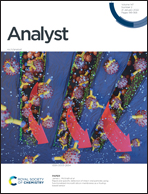A study on the detection of free and bound biotin based on TR-FRET technology
Abstract
Biotin is widely used in biological applications due to its highly selective and stable interaction with avidin, which highlights the great potential value of the quantitative determination of biotin concentration. However, the currently reported methods have many defects such as complicated operation processes and low sensitivity. Here, the time-resolved fluorescence resonance energy transfer (TR-FRET) assay is introduced to establish a convenient, rapid and sensitive biotin quantitative detection strategy. Europium cryptate (Eu3+) acts as an energy donor to label streptavidin, while APC acts as an energy acceptor to label biotin. Biotin in aqueous solution interacts with streptavidin in a competition mode. The obtained biotin detection range is 0.05–100 nM and the optimal limit of detection (LOD) of 0.03 nM biotin is obtained. Furthermore, an enzyme digestion test and a competition mode test were performed to analyze biotin in different states. The method used in this work has greatly improved the sensitivity of biotin quantitative detection and it's for the first time that a systematic study on the difference between free and bound biotin based on concentration results is conducted. It can be further extended to the detection of other biological molecules or multiplex detection of other small molecules.



 Please wait while we load your content...
Please wait while we load your content...